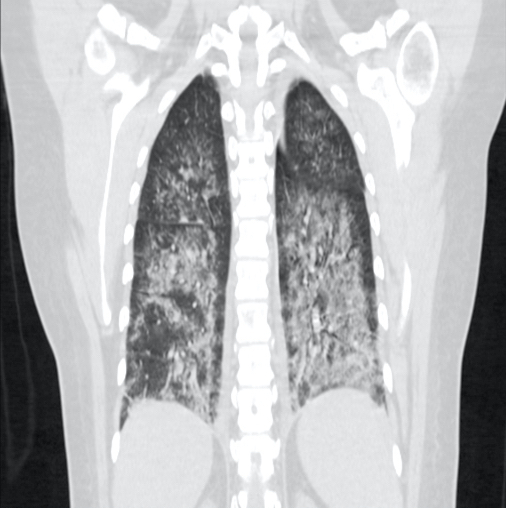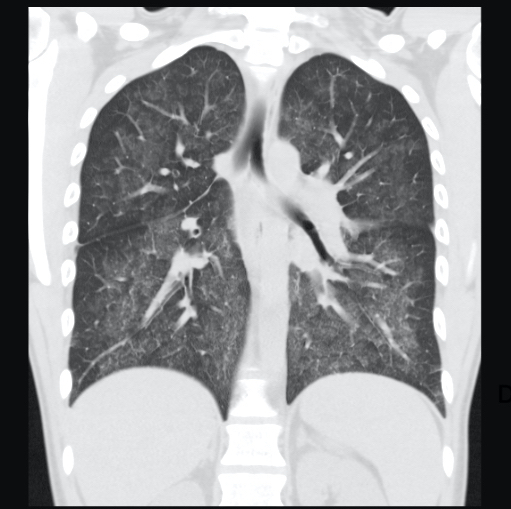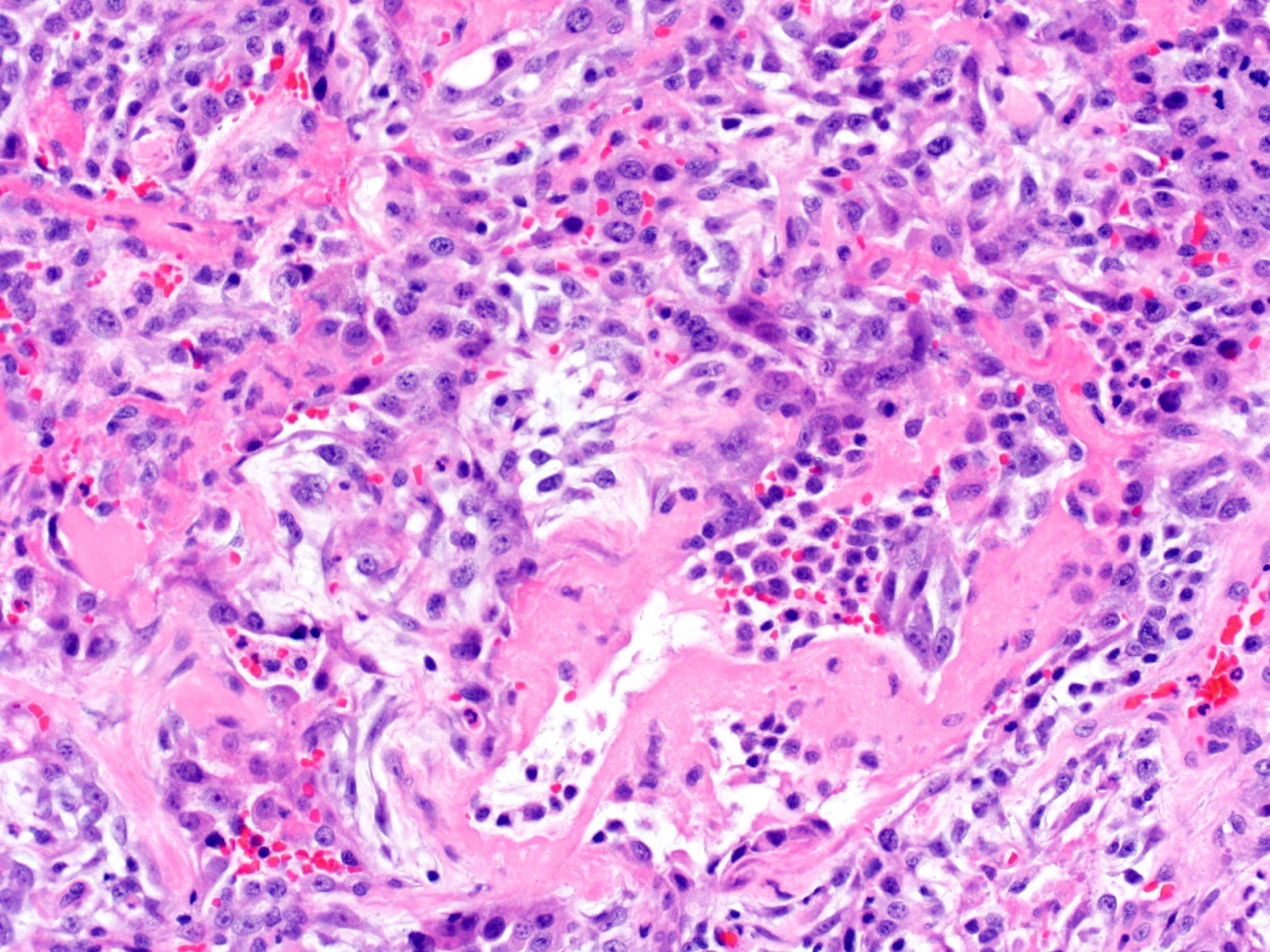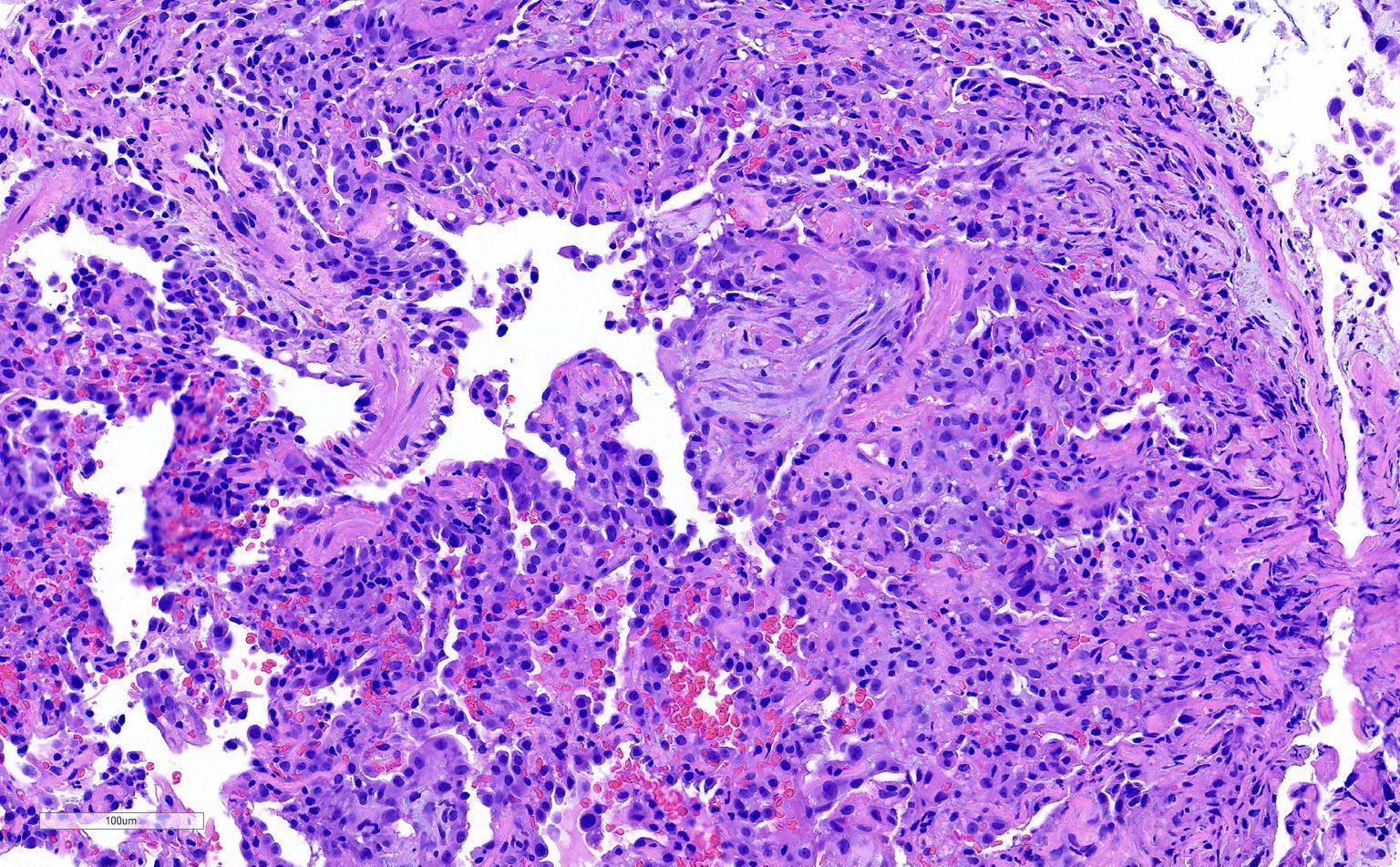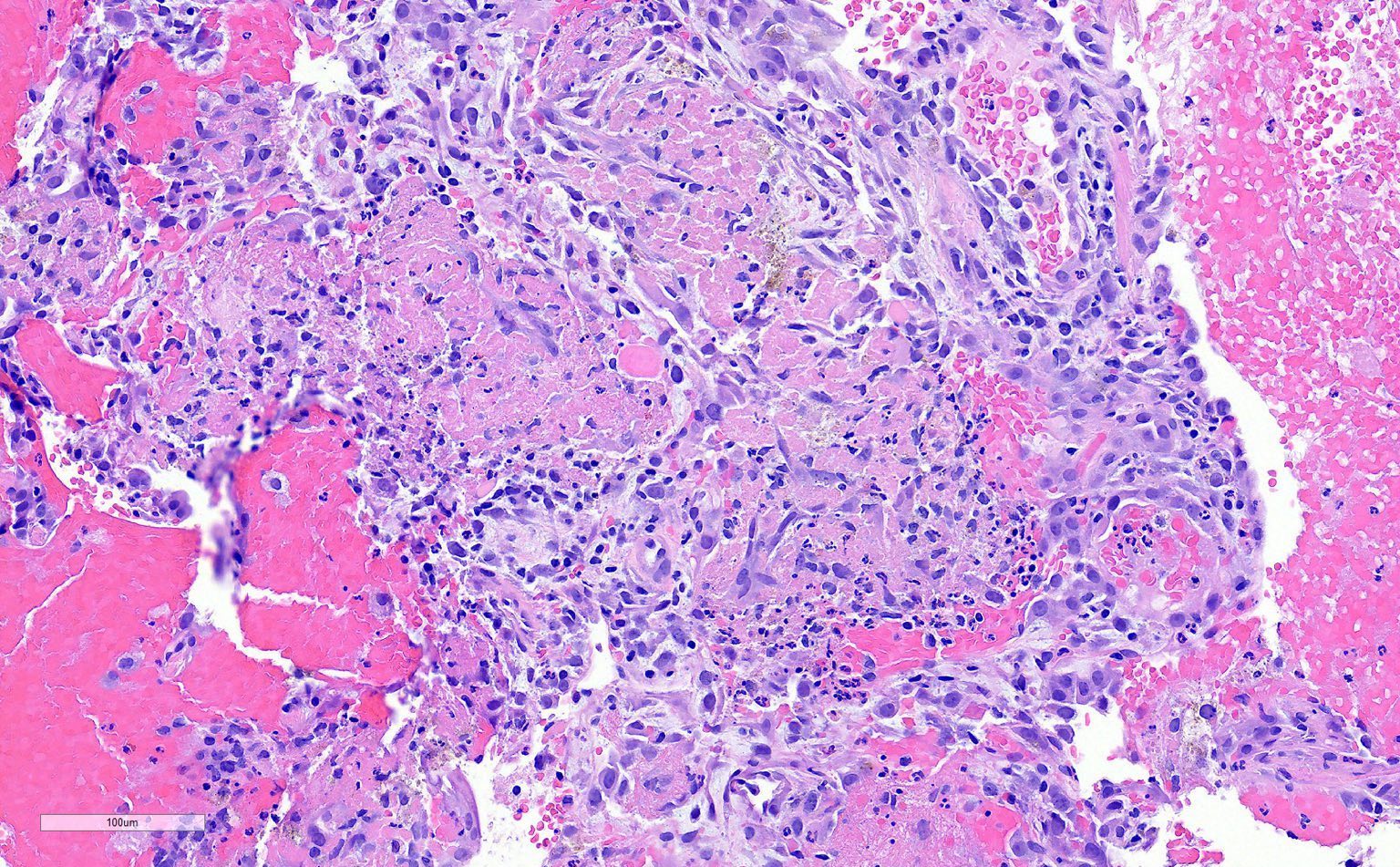Table of Contents
Definition / general | Essential features | Terminology | ICD coding | Epidemiology | Sites | Pathophysiology | Etiology | Clinical features | Diagnosis | Laboratory | Radiology description | Radiology images | Prognostic factors | Case reports | Treatment | Microscopic (histologic) description | Microscopic (histologic) images | Cytology description | Negative stains | Sample pathology report | Differential diagnosis | Board review style question #1 | Board review style answer #1 | Board review style question #2 | Board review style answer #2Cite this page: Cecchini MJ, Boland JM, Larsen BT, Yi ES. Vaping associated acute lung injury. PathologyOutlines.com website. https://www.pathologyoutlines.com/topic/lungnontumorvaping.html. Accessed May 2nd, 2024.
Definition / general
- Inhalational acute lung injury secondary to the use of e-cigarettes or other vaping devices which aerosolize fluid that is subsequently inhaled by the user
Essential features
- Spectrum of acute lung injury, from organizing pneumonia to diffuse alveolar damage
- Airway centered foamy macrophages and pneumocytes
- Bronchiolitis often also present
- Intra-alveolar fibrin in some cases
Terminology
- The Centers for Disease Control and Prevention has divided cases of vaping associated lung injury into confirmed and probable based upon the following criteria (MMWR Morb Mortal Wkly Rep 2019;68:787):
Confirmed Probable Use of an e-cigarette (vaping) or dabbing Within 90 days before symptom onset Imaging Pulmonary infiltrate, such as opacities on plain film chest radiograph or ground glass opacities on chest computed tomography Infectious workup Absence of pulmonary infection on initial workup Infection identified via culture or PCR but clinical team believes this is not the sole cause of the underlying respiratory disease process or minimum criteria to rule out pulmonary infection not met (testing not performed) and clinical team believes this is not the sole cause of the underlying respiratory disease process Alternative diagnosis No evidence in medical record of alternative plausible diagnoses (e.g., cardiac, rheumatologic or neoplastic process)
ICD coding
- ICD-10: J68.0 - bronchitis and pneumonitis due to chemicals, gases, fumes and vapors; includes chemical pneumonitis (CDC: Vaping Coding Guidance 2019 [Accessed 12 November 2019])
Epidemiology
- M:F = 2:1
- Age range: 16 - 67, with the majority of patients between 18 - 24 (MMWR Morb Mortal Wkly Rep 2019;68:860, Am J Clin Pathol 2020;153:30, N Engl J Med 2019;381:1780)
Sites
- Lung
Pathophysiology
- Currently not well understood; however, it is suspected that one or more compounds in the vaping fluid produce an acute lung injury
- Initial outbreak of illness was linked to the use of vitamin E (tocopheryl acetate) as a cutting agent for the THC, which peaked in the summer of 2019 (Arch Pathol Lab Med 2020;144:1490)
- It is not clear if other cutting agents or contaminate can produce similar acute lung injury reactions
Etiology
- Vaping is the action of using an e-cigarette, a battery powered vaporizer that uses an atomizer (small heating element and a wicking material), to aerosolize a liquid
- When the user inhales, a flow sensor activates the heating element that atomizes the liquid
- E-cigarettes use e-liquid or vape juice that usually contains predominantly propylene glycol and glycerin, with a small amount of nicotine, flavorings, additives and differing amounts of contaminants (MMWR Morb Mortal Wkly Rep 2019;68:787, Arch Pathol Lab Med 2020;144:1490)
- Some also contain cannabidiol or cannabis oil but the precise composition is rarely known
- Dabbing is a related process that involves inhaling or smoking concentrated extracts of cannabis
- Production of toxic ketene gas upon heating of vitamin E acetate has been reported (Proc Natl Acad Sci U S A 2020;117:6349)
- This offers a potential explanation for the lung injury seen in cases of EVALI related to vitamin E
Clinical features
- Patients are typically healthy prior to presentation with a history of vaping use
- Presentation is typically in an acute / subacute time frame with respiratory complaints that can mimic an infectious or inflammatory process
- Majority (but not all cases) have reported the use of tetrahydrocannabinol or cannabinoid containing products (MMWR Morb Mortal Wkly Rep 2019;68:860)
Diagnosis
- As defined by the Centers for Disease Control and Prevention, confirmed cases will have a history of vaping with exclusion of other infectious and inflammatory conditions (MMWR Morb Mortal Wkly Rep 2019;68:787)
- Biopsy is not required for diagnosis but can be supportive
Laboratory
- Negative infectious testing, including respiratory viral panel, influenza PCR, urine antigen for Streptococcus, sputum culture or bronchioloalveolar lavage culture
- Oil red O staining has been performed on bronchoalveolar lavage fluids in a number of cases with variable results; however, positive staining or a lipid laden macrophages index has not been shown to be a sensitive or specific marker for vaping associated lung injury (Am J Clin Pathol 2020;153:30)
Radiology description
- Imaging typically shows bilateral diffuse ground glass opacity and some cases have areas of nodular consolidation (AJR Am J Roentgenol 2020;214:498, N Engl J Med 2019;381:1486)
Radiology images
Prognostic factors
- Unknown
Case reports
- 28 year old man with acute respiratory failure after starting to vape with product containing tetrahydrocannabinol (Lung 2020;198:31)
- 6 men with acute respiratory illness associated with vaping nicotine and cannabis products (Am J Respir Crit Care Med 2019;200:1430)
- 8 men underwent a biopsy for acute respiratory illness associated with vaping cannabis products (Am J Clin Pathol 2020;153:30)
- 17 patients underwent a biopsy or autopsy for acute respiratory illness associated with vaping (N Engl J Med 2019;381:1780)
Treatment
- Patients have been treated with systemic glucocorticoids and supportive care (MMWR Morb Mortal Wkly Rep 2019;68:865)
- Many patients have been admitted to hospital and intensive care units with intubation required (MMWR Morb Mortal Wkly Rep 2019;68:865)
Microscopic (histologic) description
- A spectrum of acute lung injury can be observed, including (Am J Clin Pathol 2020;153:30, N Engl J Med 2019;381:1780)
- Organizing pneumonia, with mucopolysaccharide rich intraluminal plugs of proliferating fibroblasts within alveolar spaces and distal bronchioles
- Diffuse alveolar damage, with diffuse alveolar septal thickening, type II pneumocyte hyperplasia and hyaline membranes
- Acute fibrinous pneumonitis, with abundant intra-alveolar fibrin accompanied by alveolar septal edema and variable degrees of organization
- Majority of cases have foamy macrophages and foamy pneumocytes; however, this is a nonspecific finding and can also been seen in other scenarios, such as amiodarone exposure
- Neutrophils and eosinophils have also been observed in a subset of cases but eosinophils are usually rare
- No large lipid inclusions or other features of exogenous lipoid pneumonia have been observed in published cases
Microscopic (histologic) images
Cytology description
- Some reports have identified oil red O+ lipid laden macrophages in bronchoalveolar lavage fluid in the setting of vaping associated lung injury and have suggested lipoid pneumonia as the potential underlying etiology (Lung 2020;198:31, BMJ Case Rep 2018;2018:bcr2018224350, N Engl J Med 2019;381:1488)
- In the 2 larger published series of pathologic findings in vaping associated lung injury, no features of exogenous lipoid pneumonia were identified, which would classically include macrophages with coarsely vacuolated cytoplasm (Am J Clin Pathol 2020;153:30, N Engl J Med 2019;381:1780)
- Finely vacuolated foamy lipid laden macrophages are commonly seen in bronchoalveolar lavage specimens and may result from many endogenous etiologies, including acute lung injury, adverse drug reaction, infection, aspiration, autoimmune disorders, airway narrowing or obstruction and a variety of other causes (Chest 1992;102:38S, N Engl J Med 2003;348:1574, Eur Respir Rev 2017;26:170009)
- This finding is nonspecific and should not be relied upon to rule in or rule out a diagnosis of vaping associated lung injury
Negative stains
- Negative stains for fungal and acid fast organisms
Sample pathology report
- Lung, right, transbronchial biopsy:
- Diffuse alveolar damage (see comment)
- Comment: The provided clinical history of vaping is noted. Diffuse alveolar damage has been observed as one of the patterns of acute lung injury observed in patients with vaping associated lung injury. However, diffuse alveolar damage is a nonspecific pattern of acute lung injury that can be secondary to many etiologies including infection, septicemia / shock and adverse drug reaction. These other potential causes of acute lung injury must be excluded clinically.
Differential diagnosis
- Diffuse alveolar damage:
- Infection (Pneumocystis, Legionella, Mycoplasma, viral), other toxic inhalants, drug toxicity, shock, sepsis, aspiration, radiation, systemic connective tissue diseases, idiopathic
- Organizing pneumonia:
- Infection (viral, bacterial, postobstructive), other toxic inhalants, drug toxicity, radiation, collagen vascular disease, aspiration, idiopathic
Board review style question #1
Which of the following is a specific and sensitive confirmatory test for vaping associated acute lung injury?
- Congo red
- Martius scarlett blue
- Masson trichrome
- No confirmatory test exists
- Oil red O
Board review style answer #1
D. No confirmatory test exists. The histologic findings in vaping associated acute lung injury are nonspecific and there are no confirmatory tests to confirm the etiology of vaping associated lung disease. All tests, including oil red O, are nonspecific. The diagnosis of vaping associated acute lung injury is based on features of acute lung injury in the setting of appropriate exposure history and exclusion of other infectious and other causes of acute lung injury.
Comment Here
Reference: Vaping associated acute lung injury
Comment Here
Reference: Vaping associated acute lung injury
Board review style question #2
Board review style answer #2






